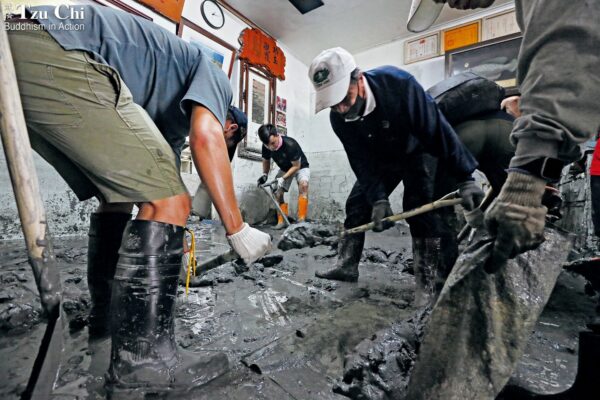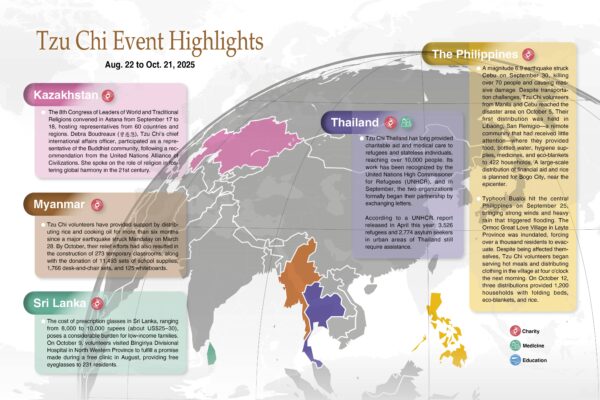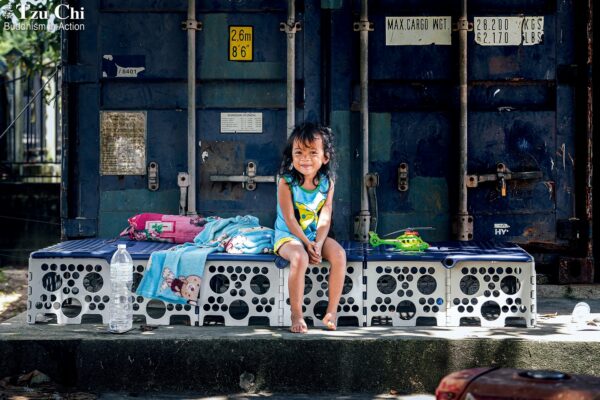Text and photos by Hsiao Yiu-hwa
Abridged and translated by Wu Hsiao-ting
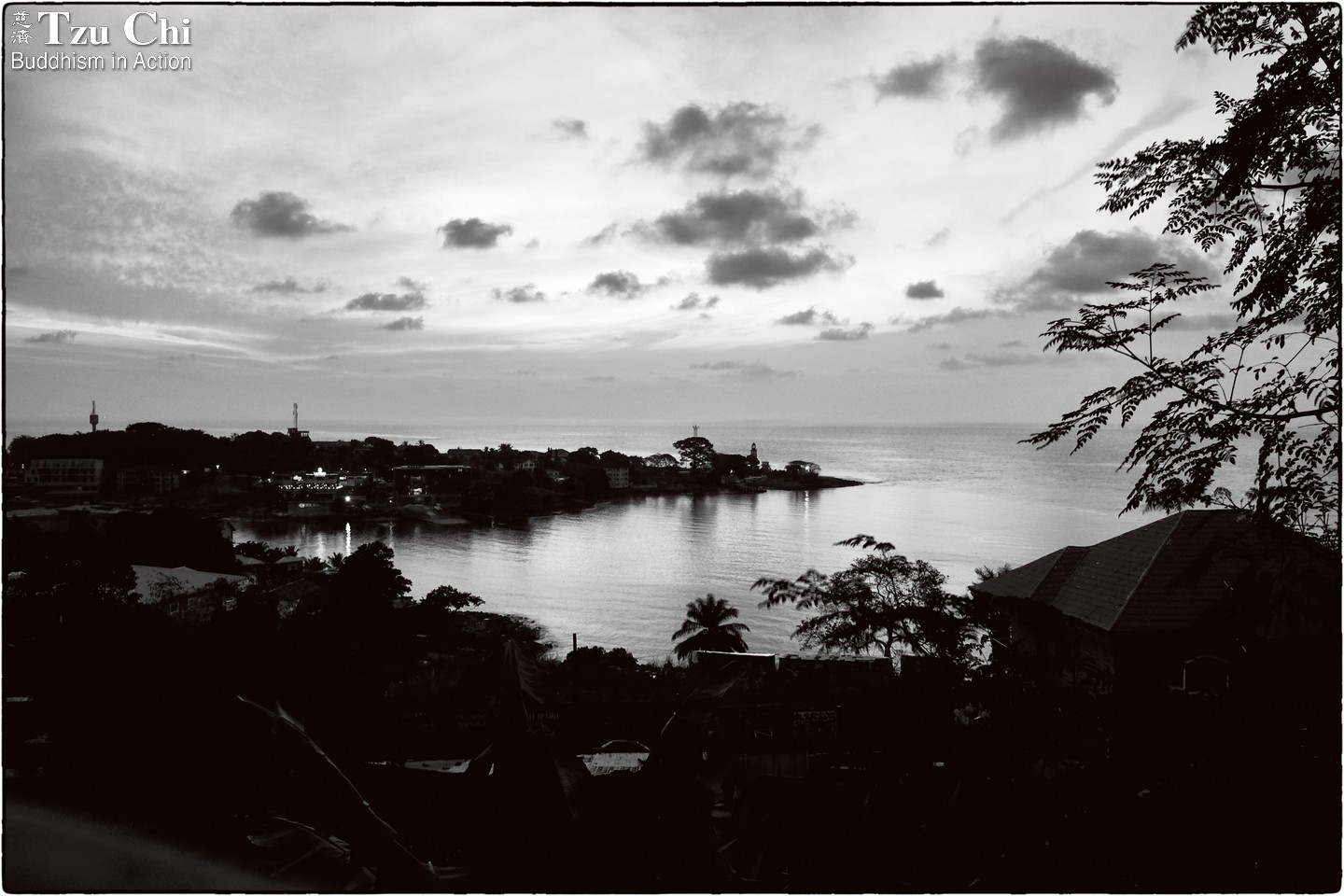
The view near dusk from a hotel room in western Freetown
I pushed open my hotel window and looked out. It was near dusk, and the tranquil seaside scenery was refreshingly beautiful. My view could easily have rivaled those offered at a typical coastal tourist destination. I was at a hotel on a small hill in western Freetown, the capital of Sierra Leone. The view I was enjoying “came at a cost”—160 U.S. dollars a day to be exact. How much money would this be to the average Sierra Leonean? I’d have to venture out of the hotel and look around the city to find out.
But first, why is Freetown named as it is? A little history lesson might be in order here.
After Sierra Leone was “discovered” by the Europeans during the great seafaring days in the mid-15th century, several countries set up trade there. Portuguese traders came first, followed by the Dutch, French, and English. The Europeans initially set their sights on the region’s rich natural resources, such as minerals and timber, but their interest shifted towards slaves as the demand for slaves in the Americas grew. Sierra Leone became an important center in the slave trade.
After the American War of Independence (1775-1783), some liberated slaves were returned to Sierra Leone. They settled in an area that was named “Free Town” to signify their newfound freedom. Since then, the town has developed from a resettlement area for freed slaves to a bustling city of more than a million people. This was how Freetown, the capital of Sierra Leone, got its name.

Hawkers with their wares on their heads
As I ambled through the downtown area of Freetown, I found every street and alley teeming with people and activity. Ambulatory vendors, with their wares on their heads, roamed the streets hawking their goods. They were selling a great number of things. It might be a few bananas, several bottles of soda, a handful of toothbrushes and toothpaste tubes, a few pairs of old shoes, some pots and pans, or sundry other items. Everything you could think of, wanted, or needed could be found on top of their heads.
To a foreigner, these super-micro, on-the-top-of-the-head businesses are very eye-catching and have a strong exotic appeal. They make great subject matter for a photographer like me. But I started to wonder: What’s their impact on the economy of Sierra Leone? I know that many local people depend upon these super-micro businesses as their source of income, but how much do they make? How much do they contribute to the economy in Sierra Leone?
I asked a soda hawker how much he earned a day. He said about two U.S. dollars. That money was used to support his family, not for his own personal use. So how large are the families in Sierra Leone? Statistics show that women in Sierra Leone give birth to an average of five children; the mothers’ average age when they have their first child is 19. Using these numbers, you can get a rough idea of how big families are here. Needless to say, the money earned by these vendors doesn’t go far.
Knowing next to nothing about market economy, I can’t definitively answer the question of just what an impact these vendors might have. But intuitively, I can’t help feeling that it is not a very productive use of the country’s labor force. A large sector of the population has been forced to take up this means of livelihood, and with so many out and about, they must not make much money.
What’s more, with so many people making a living like this, the government is missing out on much needed tax income. This in turn affects the government’s ability to pay for things people need—including medical care, education, housing, and the maintenance and construction of new infrastructure.
Everything in short supply
A look around Freetown easily reveals the inadequacies and problems Sierra Leone is facing. Walk into Connaught Hospital, built in 1912 when the nation was still a British colony, and you are immediately struck by the severe lack of medical resources. Though Connaught Hospital is the largest medical facility in Sierra Leone, medical equipment and tools are old and in extremely short supply. Four dialysis machines, donated a few years earlier by Israel, are here at Connaught. These four machines are the only such machines in the entire country—and three are out of order. That leaves only one functioning dialysis machine in the whole of Sierra Leone. When a hospital of this scale does so poorly, what must it be like for other medical facilities around the nation?
Everything is in short supply. There is an inadequate number of physicians, an inadequate number of beds, an inadequate number of everything. The only thing not in short supply are patients—there never seems to be an end to them. The acute lack of healthcare professionals and medical infrastructure triggered a nationwide strike of doctors in Sierra Leone in December 2018. The protestors asked for medical equipment purchases, additional resources, higher pay, as well as other improvements. The strike lasted 13 days and paralyzed hospitals nationwide.
The country’s medical conditions are in shambles, but the educational sector is doing hardly any better. The law requires nine years of free and compulsory schooling, but a shortage of schools, teachers, and funding has made implementation unfeasible.
Sierra Leone emerged from 11 years of devastating civil conflict in January 2002. The war led to the destruction of nearly 1,300 primary schools. Near the end of the war, in 2001, 67 percent of school-age children were not attending school. Though the situation has greatly improved since then, there is still a long way to go to reach the nation’s basic requirements.
What about public hygiene? Public infrastructure? Social welfare? How much longer do the citizens of Sierra Leone have to wait until they can enjoy the basic entitlements and privileges that people elsewhere take for granted? I’m afraid even concerned government officials have no answer to that question.
Lending a helping hand
Covering an area of 71,740 square kilometers (27,700 square miles), Sierra Leone is twice the size of Taiwan. The nation is rich in natural resources, including diamonds, gold, and titanium ore. Even so, a high percentage of its seven million people still live below the poverty line.
Inadequate medical care, insufficient educational resources, poor public infrastructure—when you look at all the problems the country is facing, you can’t help but wonder what on earth went wrong. Is it the nation’s system of government? Poor efficiency? Human factors or other issues? Whatever the reasons, they were not something a foreigner like me who was only there for a short time could fully comprehend.
When I returned to my hotel, I pushed open my window and looked out at the peaceful sea again. As I took in that picturesque, 160-dollar-a-day view, the agitation I was feeling from my trip around town gradually began to subside. As I stood there, looking out, my thoughts turned to the locals I saw on the streets struggling to make a living. I felt guilty at how expensive my accommodation was in comparison. However, guilty or not, I didn’t have much choice in the matter. Without exception, hotel rooms in Sierra Leone cost upwards of a hundred U.S. dollars a night. How can they charge such prices and get away with it? It’s because they cater to foreigners, not the locals.
Why do foreigners visit Sierra Leone? For most, it’s not the sightseeing. A large proportion of foreigners consist of businesspeople in the country seeking business opportunities. Another large group is NGO personnel who are in the nation to implement humanitarian aid work. I was in this latter category. I had come to the country with a group of Tzu Chi volunteers, who had paid their own way to carry out the foundation’s philanthropic work for people in need. They were also learning more about what the foundation could do for a nation rated as one of the poorest in the world.
Tzu Chi has aided the underserved in Sierra Leone since 2015, in the hope of bringing some relief to a people who have suffered through a brutal decade-long civil war, a deadly Ebola virus epidemic from 2014 to 2016, and recent devastating natural disasters. Without a doubt, this is a country in which Tzu Chi will continue to expend its resources and efforts. When will their efforts bear fruit? I’m not sure. But I’m positive they will keep at their work, without complaint, because they know that they are just doing what humans should do.
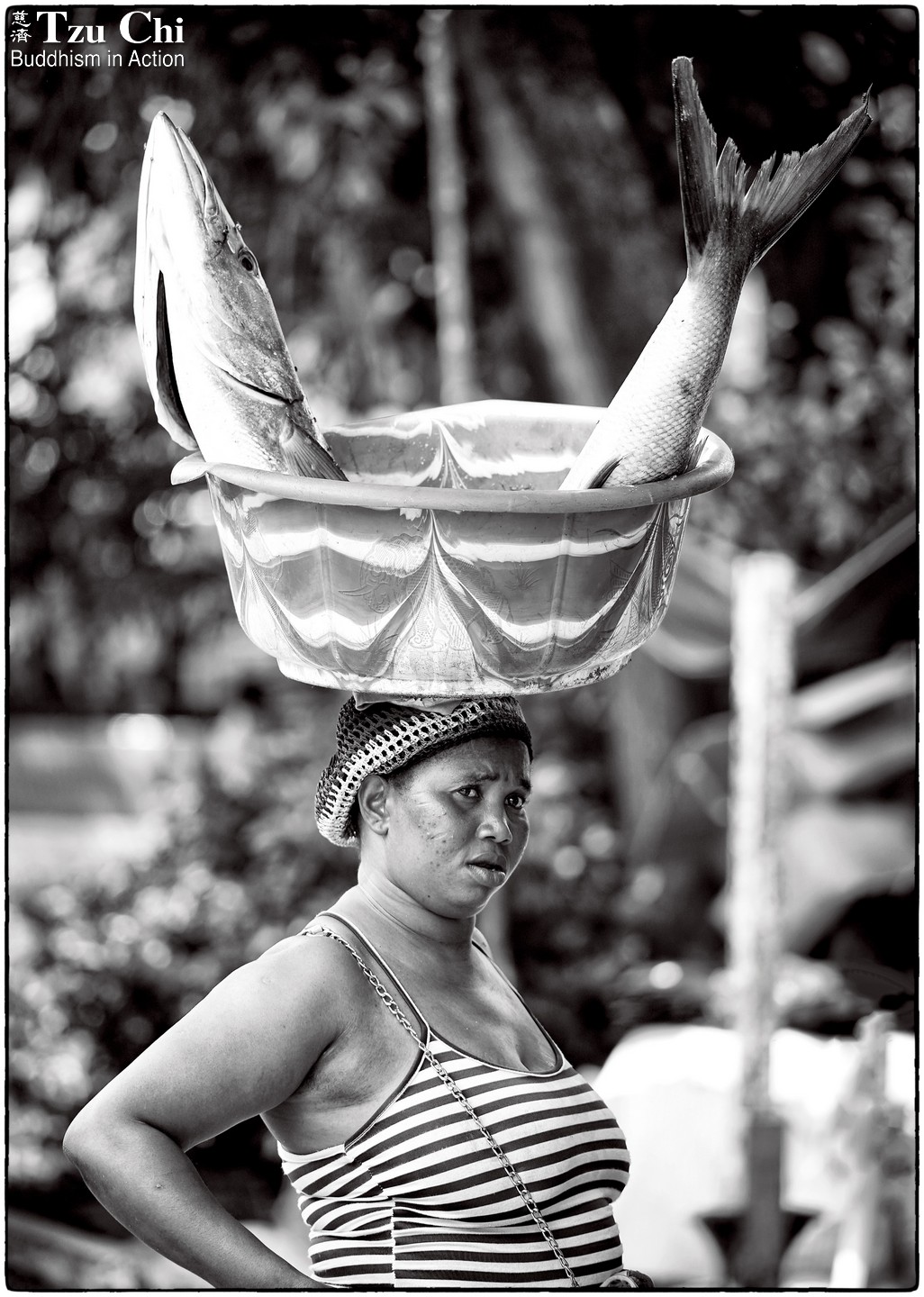
A woman sells fish balanced on top of her head on a street in Freetown.
Time Frozen in Bustling Street Scenes
An outdoor market in Freetown’s downtown area is crowded with people buying and selling. The city center is full of hustle and bustle all day long.
Great Britain ended its colonial rule of Sierra Leone in 1961. A postbox from the colonial days still stands on the side of a street in Freetown. It indicates that the city has not made much progress in terms of urban planning and development since then.
Freetown is not large geographically, but one seventh of Sierra Leone’s population strives to make a living there. The pressure to stay afloat is understandably intense.
Super-Mini Stores on Their Heads
In Freetown, as throughout the entire country, ambulatory vendors hawking goods balanced on their heads are everywhere. They walk around the streets at any time and place, on the lookout for potential customers. This is how they make a living. A large percentage of people in Sierra Leone strive to keep themselves and their families fed by running this kind of super-micro business.
Medically Underserved, Health Unguarded
- Aided by a pair of crutches, a polio victim forges ahead on the rough path facing him in life.
- An old man with an injured leg sits outside Connaught Hospital in Freetown.
- A dilapidated bed still in use in the government-run Connaught Hospital
- A billboard like this one, promoting the prevention of HIV, is a common sight in Sierra Leone.
These scenes, common in Freetown, provide a glimpse into a country in which there is still a lot of room for improvement in the areas of medical care and public health.
Survival Challenges From an Early Age
- Children wait in the rain for the distribution of hot food by Tzu Chi. One of them shields herself from the rain with a container she brought to hold the food.
- This 38-year-old woman says she has five children, one cradled in her arm, one lying across her thigh, two flanking her, and one standing to her left with her arms crossed over her chest. The woman exemplifies the typical mother in Sierra Leone. Statistically, women in Sierra Leone give birth to an average of five children. According to the World Health Organization, Sierra Leone had the highest maternal mortality rate in the world in 2015. The country also has one of the highest infant and under-five mortality rates.
A Shortage of Educational Resources
- Students in class in a primary school in Tombo. This private school was converted from a deserted warehouse. The indoor space is divided by wooden poles and recycled sacks into seven classrooms for a hundred to 150 students. There is no lighting or air conditioning. With so many children crowded together for lessons, the teaching quality and learning efficiency are quite debatable.
- A scene from a primary school classroom located next to Grafton Amputee Camp in Western Area. Nearly 1,300 primary schools were destroyed during the Sierra Leone civil war, between 1991 and 2002. The nation’s educational sector has not yet recovered from the devastation.
No Way Out for Slum Residents
- Kroo Bay is a slum in central Freetown. This community is a microcosm of the general living conditions in Sierra Leone—no running water or electricity, poor sanitary conditions, and overcrowdedness.
- Young people in a slum idle away their time. Sierra Leone has a high unemployment rate. Faced with a shortage of job opportunities, young people are powerless and see no future for themselves. The cycle of poverty and their aimlessness have negative effects at the individual and societal levels.
Tzu Chi Volunteers Reaching Out
- Two visually impaired girls at Paul School for the Blind, located in Bo, play with each other. This school enrolls pupils from extremely destitute families. Through the recommendation of the Lanyi Foundation, one of Tzu Chi’s three partners in Sierra Leone, Tzu Chi has decided to help the school repair its dormitory floor and replace broken bed frames.
- Tzu Chi volunteers lead a group activity during a visit to an approved school (for juvenile offenders) in Freetown. Bringing aid to the institution, the volunteers gave the youngsters their best wishes and encouraged them to learn job skills to facilitate their return to society.

